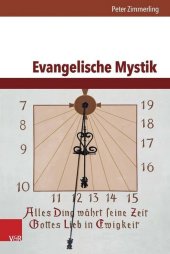 Neuerscheinungen 2015Stand: 2020-02-01 |
Schnellsuche
ISBN/Stichwort/Autor
|
Herderstraße 10
10625 Berlin
Tel.: 030 315 714 16
Fax 030 315 714 14
info@buchspektrum.de |

Peter Zimmerling
Evangelische Mystik
2015. 283 S. mit 11 Abb. 23.2 cm
Verlag/Jahr: VANDENHOECK & RUPRECHT 2015
ISBN: 3-525-57041-4 (3525570414)
Neue ISBN: 978-3-525-57041-8 (9783525570418)
Preis und Lieferzeit: Bitte klicken
Geschichte, Theologie und Praxis der evangelischen Mystik.
"Mystik ist katholisch. Mystik und Protestantismus passen nicht zusammen." Diese Meinung ist weit verbreitet, aber trotzdem falsch. Stattdessen stellt sich das Verhältnis von Mystik und Protestantismus als eine Problemgeschichte dar. Phasen der Hochschätzung und solche der Ablehnung wechselten einander ab. Seit der Reformation gab es Männer und Frauen, die dem Mainstream des Protestantismus angehören, deren Glaube und Theologie mystisch geprägt waren. Martin Luthers (1483-1546) reformatorische Erkenntnis entsprang einer mystischen Erfahrung. Seine reformatorische Theologie war mystisch orientiert. Philipp Nicolai (1556-1608), Paul Gerhardt (1607-1676), Johann Sebastian Bach (1685-1750), Gerhard Tersteegen (1697-1769) und Nikolaus Ludwig von Zinzendorf (1700-1760) verliehen in Liedern und Musik ihren mystischen Erfahrungen klassischen Ausdruck. Selbst Leben und Werk protestantischer Zeitgenossen aus dem 20. Jh. wie Dag Hammarskjöld (1905-1961), Dietrich Bonhoeffer (1906-1945) und Dorothee Sölle (1929-2003) waren mehr oder weniger offensichtlich mystisch geprägt. Sölle bekannte sich klar zur Mystik als einer Angelegenheit nicht von wenigen, sondern von allen Menschen. Tatsächlich war protestantische Mystik von Anfang an keine Angelegenheit religiöser Eliten, sondern stand allen offen. Da die evangelischen Choräle mystisch geprägt waren und das Abendmahl mystisch verstanden wurde, bot gerade der lutherische Gottesdienst allen Christen Zugang zu mystischem Glauben.
´Mysticism is Catholic. Mysticism and Protestantism don´t go together.´ This opinion is widely spread, but nevertheless wrong. Instead, the history of the relationship of mysticism and Protestantism is a complicated one. At times, mysticism was highly regarded, while at others it was rejected by the Protestant theologians. Ever since the reformation there were men and women belonging to the mainstream of Protestantism whose faith and theology were shaped by mysticism. Martin Luthers reformatory discovery was the result of a mystic experience. His theology was oriented towards mysticism. Philipp Nicolai, Paul Gerhardt, Johann Sebastian Bach, Gerhard Tersteegen und Nikolaus Ludwig von Zinzendorf expressed their mystic experiences in their hymns and music. Even the lives and works of Protestants in the 20thcentury like Dag Hammarskjöld, Dietrich Bonhoeffer and Dorothee Sölle were more or less influenced my mysticism. Sölle clearly stated that mysticism wasn´t just a matter for a few, but for everyone. Indeed, Protestant mysticism was from the beginning not restricted to the religious elite, but open to everyone. As the Protestant hymns were influenced by mysticism, and the Lord´s Supper was interpreted mystically, the Lutheran church service itself offered access to a mystic faith to all Christians.


